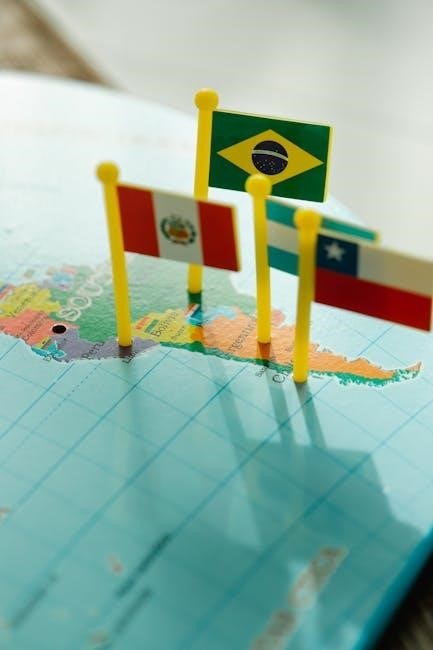Overview of the Study Guide
This study guide provides a comprehensive analysis of global warfare from 1900 to the present, focusing on power shifts, technological advancements, and geopolitical impacts, designed to enhance students’ understanding of modern conflicts.
Unit 7: Global Warfare explores the transformative conflicts and geopolitical shifts from 1900 to the present, focusing on World Wars I and II, the Cold War, and modern warfare. This unit examines how internal and external factors, such as nationalism, imperialism, and technological advancements, reshaped global power structures. Key themes include the decline of traditional empires, the rise of new nations, and the evolution of military strategies. By analyzing these events, students gain insight into how global warfare has influenced modern international relations, societal changes, and economic dynamics. This introduction sets the stage for understanding the complexities of warfare and its lasting impact on the world.
Learning Objectives and Historical Developments
This section outlines the learning objectives and historical developments central to Unit 7: Global Warfare. Students will analyze the causes and consequences of global conflicts, such as World Wars I and II, and the Cold War. Key objectives include understanding how internal and external factors drove power shifts, the impact of technological advancements on warfare, and the decline of traditional empires. Historical developments explored include the rise of fascism, the formation of international alliances, and the decolonization of nations. By examining these themes, students will gain a deeper understanding of how global warfare has shaped modern international relations and geopolitical structures.

Shifting Power Dynamics After 1900
Shifting power dynamics after 1900 were driven by internal instability in traditional empires and external pressures like geopolitical tensions, leading to their decline and the rise of new global powers.
Internal and External Factors Contributing to Change
Internal factors, such as political instability, economic strain, and social unrest, weakened traditional empires, while external pressures like geopolitical rivalries and rising nationalism accelerated their decline. The rise of new global powers, including the United States and Japan, further shifted the balance. Economic disparities and revolutionary ideologies also played a role in reshaping global power structures; These internal and external forces intersected, creating a volatile landscape that set the stage for global conflicts like World Wars I and II. Understanding these dynamics is crucial for analyzing how power shifted and how it reshaped the modern world order.
Decline of Traditional Empires
The decline of traditional empires after 1900, such as the Ottoman, Austro-Hungarian, and Russian Empires, was driven by internal decay and external pressures. Political instability, economic strain, and social unrest eroded their foundations. Nationalist movements and the rise of new powers further weakened these empires. World War I accelerated their collapse, with the Treaty of Versailles redrawing borders and creating new states. Economic exhaustion and revolutionary ideologies, like communism, also contributed to their downfall. This decline reshaped global power structures, leading to the emergence of new nations and alliances, and set the stage for future conflicts, marking the end of an era dominated by traditional empires.

World War I (1914-1918)
World War I was a global conflict marked by trench warfare, massive casualties, and the introduction of new military technologies, reshaping societies and international relations forever.
Causes and Key Events of World War I
The causes of World War I included nationalism, imperialism, militarism, and the complex system of alliances, with the assassination of Archduke Franz Ferdinand as the immediate trigger. Key events like the Battle of the Somme and Verdun showcased the brutality of trench warfare, while the U.S. entry in 1917 shifted the war’s balance. The Treaty of Versailles (1919) ended the conflict but imposed harsh penalties on Germany, fueling resentment. The war resulted in unprecedented human casualties, economic devastation, and the collapse of empires, reshaping global power structures and laying the groundwork for future conflicts like World War II.
Impact of World War I on Global Power Structures
World War I significantly altered global power structures, leading to the collapse of empires and the rise of new nations. The defeat of the Central Powers resulted in the dissolution of the Ottoman, Austro-Hungarian, and German Empires, with the Treaty of Versailles redrawing national borders. This led to the emergence of new states in Eastern Europe and the Middle East. The war also weakened European dominance, creating a power vacuum that set the stage for the rise of the United States and the Soviet Union. Additionally, the war’s economic toll and widespread devastation contributed to political instability, fostering conditions that would eventually lead to World War II.

The Interwar Period (1918-1939)
The interwar period (1918-1939) was marked by the rise of fascism, global economic crisis, political instability, and the rise of nationalist tensions, leading to World War II.
Rise of Fascist and Nationalist Ideologies
The interwar period saw the rise of fascist and nationalist ideologies, fueled by post-World War I economic instability and political upheaval. Leaders like Mussolini in Italy, Hitler in Germany, and Hirohito in Japan promoted aggressive nationalism, authoritarianism, and militarism. These ideologies emphasized racial and national superiority, leading to territorial expansion and increased tensions between nations. Fascist regimes centralized power, suppressed dissent, and glorified war as a means to achieve national greatness. Nationalist movements also emerged in response to perceived injustices from the Treaty of Versailles, fostering a culture of revenge and aggression. These ideologies laid the groundwork for World War II and reshaped global power dynamics.
Economic and Political Instability
The interwar period was marked by severe economic and political instability, which destabilized global power structures; The Great Depression (1929-1939) caused widespread unemployment, economic collapse, and social unrest, weakening democratic governments. Hyperinflation in Germany and economic crises in other nations fueled resentment and political extremism. Politically, the collapse of empires after World War I created power vacuums, leading to the rise of authoritarian regimes. Treaties like Versailles imposed harsh penalties, fostering nationalist sentiments and revengeful ideologies. These factors created a volatile environment, enabling fascist and nationalist movements to thrive. Economic and political instability became catalysts for global conflict, as nations sought to expand territories and resources to address internal crises.

World War II (1939-1945)
World War II was the deadliest conflict in history, involving major global powers. It began with Germany’s invasion of Poland and escalated into a worldwide conflict, marked by the Holocaust, the use of atomic bombs, and the emergence of the U.S. and USSR as superpowers.
Causes and Key Events of World War II
World War II arose from the Treaty of Versailles’ harsh terms, economic instability, and the rise of fascist regimes in Germany, Italy, and Japan. Hitler’s aggressive expansion, Mussolini’s imperialism, and Japan’s militarism destabilized global security. The invasion of Poland in 1939 triggered the war in Europe. Key events included the Battle of Britain, Operation Barbarossa, and the Holocaust, which systematically murdered six million Jews. The Pacific Theater saw Japan’s attack on Pearl Harbor, the Battle of Midway, and the atomic bombings of Hiroshima and Nagasaki. These events shaped the war’s trajectory, leading to the Axis powers’ defeat and profound global repercussions.
Impact of World War II on Global Power Structures
World War II profoundly reshaped global power structures, leading to the emergence of the United States and the Soviet Union as superpowers. The war’s conclusion marked the decline of European colonial empires, as nations in Africa, Asia, and the Middle East sought independence. The Yalta and Potsdam Conferences established the framework for post-war alliances, resulting in the formation of NATO and the Warsaw Pact. The war also prompted the creation of the United Nations to foster international cooperation and prevent future conflicts. Additionally, the dropping of atomic bombs introduced the nuclear age, redefining military strategies and global security dynamics for decades to come.

The Cold War (1947-1991)
The Cold War was a period of ideological and geopolitical tension between the U.S. and the Soviet Union, marked by proxy wars, the Cuban Missile Crisis, and an arms race.
Causes and Key Events of the Cold War
The Cold War (1947-1991) was rooted in ideological tensions between the U.S. and the Soviet Union, with capitalism and communism at its core. Post-WWII territorial disputes, the Truman Doctrine, and the Marshall Plan exacerbated divisions. Key events included the Berlin Blockade (1948-1949), the Korean War (1950-1953), and the Cuban Missile Crisis (1962), which brought the world to the brink of nuclear war. The Space Race and proxy wars in Vietnam and Afghanistan further highlighted the rivalry. The collapse of the Soviet Union in 1991 marked the end of the Cold War, leaving the U.S. as the world’s sole superpower.
Impact of the Cold War on Global Power Structures
The Cold War profoundly reshaped global power structures, establishing the U.S. and the Soviet Union as superpowers. It led to the formation of NATO and the Warsaw Pact, dividing the world into ideological blocs. The collapse of the Soviet Union in 1991 marked the end of bipolarity, leaving the U.S. as the world’s sole superpower. The Cold War also accelerated decolonization, as European empires dissolved, and new nations emerged. Geopolitical alliances and rivalries were redrawn, creating a legacy of tension and competition. The era’s conclusion ushered in a unipolar world order, with the U.S. dominating global politics, economics, and military affairs, setting the stage for modern international relations.

Technological Advancements in Warfare
Technological advancements in warfare introduced new weapons and strategies, such as machine guns, tanks, and atomic bombs, increasing efficiency and destructiveness in conflicts globally.
New Weapons and Strategies
The introduction of machine guns, tanks, and poison gas in World War I revolutionized battlefield tactics, leading to trench warfare and increased casualties. World War II saw advancements like strategic bombing, jet aircraft, and atomic bombs, expanding warfare’s scale and destructiveness. The Cold War introduced missile technology and nuclear deterrence, shifting strategies towards proxy wars and espionage. These innovations required new tactics, including guerrilla warfare and counterinsurgency, adapting to asymmetric threats. The development of these weapons and strategies changed warfare’s nature, having profound societal and geopolitical impacts, reshaping global power dynamics and international relations.
Impact of Technological Advancements on Warfare
Technological advancements have profoundly influenced warfare, increasing efficiency and lethality. New weapons like machine guns, tanks, and atomic bombs caused unprecedented destruction, while innovations in aviation and missiles expanded conflict scales. The Cold War’s nuclear deterrence reshaped global strategies, emphasizing proxy wars and espionage. Modern technologies, such as drones and cyber warfare, allow for precise and covert operations, reducing direct casualties but raising ethical concerns. These developments have shifted military tactics, amplified societal impacts, and redefined international relations, highlighting the dual role of technology as both a tool for defense and a force for devastation.

Geopolitical Changes and International Relations
Global warfare reshaped international relations, with shifting alliances, decolonization, and the rise of superpowers like the U.S. and USSR, transforming the global political landscape.
Formation of International Alliances
The formation of international alliances played a crucial role in shaping global warfare dynamics. During World War I, alliances such as the Triple Entente and Triple Alliance drew nations into conflict, creating a complex web of political and military obligations. Similarly, World War II saw the emergence of the Axis and Allied powers, which fundamentally influenced the war’s trajectory. The Cold War further solidified alliances through organizations like NATO and the Warsaw Pact, establishing clear ideological divides. These alliances not only determined the course of conflicts but also reshaped the global power structure, fostering both cooperation and tension among nations. The creation of such alliances underscores the interconnected nature of modern warfare and international relations.
Decolonization and Rise of New Nations
Decolonization after World War II led to the emergence of newly independent nations, primarily in Africa, Asia, and the Middle East. European empires, weakened by the war, could no longer maintain their colonies. Nationalist movements, fueled by local resistance and international pressure, demanded self-governance. The United States and the Soviet Union, as rising superpowers, often supported decolonization to expand their influence. However, newly independent nations faced challenges, including political instability, economic struggles, and Cold War rivalry. Decolonization reshaped global power structures, ending European dominance and creating a multipolar world. This period marked a significant shift in international relations, with former colonies becoming key players in global geopolitics.
Modern Global Warfare (21st Century)
Modern global warfare involves asymmetric conflicts, terrorism, and cyberwarfare, with technological advancements like drones and digital espionage reshaping military strategies and geopolitical tensions in the 21st century.
Asymmetric Conflicts and Terrorism
Asymmetric conflicts and terrorism have become defining features of modern global warfare. These involve non-state actors, such as insurgent groups or terrorists, using unconventional tactics to counter traditional military powers. Terrorism, often targeting civilians, aims to instill fear and destabilize societies. Groups like Al-Qaeda and ISIS have employed guerrilla warfare, suicide bombings, and digital propaganda to achieve their goals. Asymmetric conflicts challenge conventional military strategies, emphasizing psychological impact over direct battlefield victories. The rise of such tactics reflects broader shifts in global power dynamics, with non-state actors increasingly influencing international relations and security frameworks in the 21st century.
Role of Technology in Modern Warfare
Technology has revolutionized modern warfare, introducing advanced tools like drones, artificial intelligence, and cyber warfare. These innovations enable precise targeting, real-time intelligence, and unmanned operations, reducing human casualties while enhancing efficiency. Cyberattacks now disrupt enemy systems, blurring the lines between traditional combat and digital warfare. AI-driven systems improve decision-making and logistics, while advancements in surveillance and communication ensure better coordination. However, these technologies raise ethical concerns, such as accountability for autonomous weapons and the potential for global cyber conflicts. The integration of technology in warfare continues to evolve, shaping future military strategies and redefining the nature of global conflict in the 21st century.

Impact of Global Warfare
Global warfare has caused widespread devastation, impacting societies, economies, and the environment. It has led to immense human suffering, loss of life, and long-term global instability.
Human Casualties and Societal Impacts
Global warfare has inflicted immense human suffering and societal disruption. World Wars I and II caused unprecedented casualties, with millions of soldiers and civilians killed or wounded. The introduction of trench warfare, total war strategies, and weapons of mass destruction exacerbated the devastation. Civilian populations were increasingly targeted, leading to widespread displacement and societal trauma. The Holocaust during World War II remains a stark reminder of humanity’s darkest atrocities. The Cold War’s proxy conflicts and ideological tensions perpetuated instability, while modern asymmetric conflicts and terrorism continue to target innocent civilians. These events have left deep scars, shaping global perceptions and fostering long-term societal and psychological impacts.
Economic and Environmental Consequences
Global warfare has caused profound economic and environmental devastation. Wars disrupted trade, drained resources, and led to widespread destruction of infrastructure, crippling economies and fostering long-term instability. The environmental impact has been severe, with deforestation, oil spills, and chemical weapons contaminating ecosystems. World Wars I and II saw industrial-scale resource depletion, while the Vietnam War’s use of Agent Orange caused lasting ecological damage. Modern conflicts continue to degrade environments, with warfare contributing to climate change through carbon emissions and habitat destruction. Economic costs, including reconstruction expenses and lost productivity, have burdened nations, while environmental damage threatens biodiversity and future generations, underscoring the dual toll of war on humanity and the planet.

Key Theoretical Perspectives
Nationalism, imperialism, and ideological tensions are central to understanding global warfare, shaping conflicts and international relations through competing interests and power struggles.
Nationalism, Imperialism, and Ideological Tensions
Nationalism, imperialism, and ideological tensions have been pivotal in shaping global warfare. Nationalism fueled loyalty to nations, often leading to conflicts over territorial claims and self-determination. Imperialism drove competition for colonies and resources, exacerbating tensions between global powers. Ideological tensions, particularly between democracy, fascism, and communism, underpinned many conflicts, such as World Wars I and II and the Cold War. These forces intersected, creating complex geopolitical dynamics that influenced military strategies, alliances, and the rise and fall of empires. Understanding these concepts is crucial for analyzing the root causes and enduring impacts of global warfare.
Modern Theories of Warfare and International Relations
Modern theories of warfare and international relations emphasize the complexity of contemporary conflicts. Concepts like deterrence, asymmetric warfare, and hybrid warfare explain how non-state actors and technological advancements have redefined traditional military strategies. Realist, liberal, and constructivist theories provide frameworks for understanding state behavior, power dynamics, and cooperation. Game theory and the security dilemma highlight how nations balance cooperation and competition. These theories also address the role of international organizations and norms in shaping global security. By integrating historical and contemporary perspectives, modern theories offer insights into the evolving nature of warfare and the challenges of maintaining international stability in a rapidly changing world.
Unit 7: Global Warfare explores the transformative impact of conflicts from 1900 to the present, shaping modern international relations, power structures, and societal dynamics.
Unit 7: Global Warfare examines transformative conflicts from 1900 to the present, highlighting their impact on power structures, societies, and international relations. Key themes include the decline of traditional empires, the rise of new global powers, and the role of ideology in shaping conflicts. World Wars I and II, the Cold War, and modern asymmetric warfare are explored, emphasizing technological advancements, geopolitical shifts, and human costs. The unit also addresses decolonization, the emergence of superpowers, and the evolution of warfare strategies. These concepts provide a foundation for understanding the complexities of global conflict and their enduring influence on the modern world.
Final Thoughts on Global Warfare
Global warfare from 1900 to the present has profoundly shaped the modern world, highlighting the devastating consequences of conflict and the importance of diplomacy. The rise and fall of empires, ideological struggles, and technological advancements underscore the complexity of warfare. Understanding these dynamics is crucial for addressing contemporary challenges, including terrorism, nuclear threats, and geopolitical tensions. By examining historical patterns and their legacies, students can gain insights into fostering peace and cooperation in an increasingly interconnected world. This study guide equips learners with a nuanced perspective on global warfare, emphasizing its enduring impact on humanity and international relations.